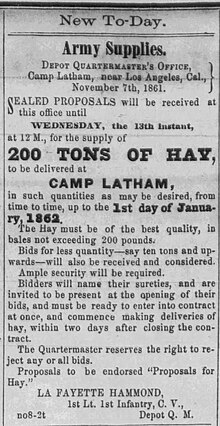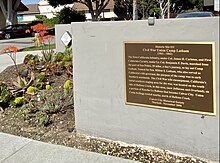Camp Latham
| Camp Latham | |
|---|---|
| La Ballona Township, Los Angeles County, California in United States | |
 Military Department of California, c. 1858 | |
| Coordinates | 34°00′22″N 118°23′42″W / 34.0060°N 118.3950°W |
| Site information | |
| Owner | United States Army |
| Site history | |
| Built | 1861 |
| In use | 1862 |
| Fate | Closed, troops relocated to Camp Drum |
Camp Latham was a temporary United States Army tent camp in Los Angeles County, California extant from fall 1861 to fall 1862 in the military District of Southern California during the American Civil War. Camp Latham was located on the south bank of Ballona Creek, approximately .75 mi (1.21 km) southwest of what is now called Culver City station.[1][2] Short-lived Camp Kellogg was located nearby, just north across the creek.[3][4]
Background
While located well outside of the disputed battleground of the American Civil War, the
Demonstrations in Los Angeles and other Southern California towns had shown that much of the local population, perhaps a majority, were Southern sympathizers, and a "secession company" was even holding public drills, deliberately displaying the
Bear Flag instead of the Stars and Stripes. The military units ordered to the Los Angeles post were encamped first close to town at a site called Camp Fitzgeraldafter a recently deceased Ft. Tejon officer, then moved to the new Camp Latham, located eight miles southwest, where Culver City is today.
Additionally, a word about the weather in the West at the beginning of the Civil War era may be helpful in setting the scene at Camp Latham. Per a
History
Camp Latham was established by the
By October 2, the local pro-Union newspaper
Camp Kellogg was seemingly founded February 4, 1862 with the contents of 26 wagons and the soldiers of companies C, E, F, G, and I of the Fifth Regiment, arrived from San Pedro.
Also in March 1862 an intoxicated soldier named George McDermott stabbed to death a local man named Guadalupe Moreno, at "a low liquor shanty operated by a Mexican" that was located just outside the perimeter of Camp Latham.[19] Per the Weekly Butte Record, "The murderer was sent to town under a guard of soldiers, and placed in jail. He attempted to escape after committing the deed. He is said to be only twenty years of age, and until this time was never known to drink, and had always borne a good character. A bill has been found against him for murder by the Grand Jury."[20] In April 1862 McDermott was sentenced to 10 years "in the penitentiary" by the Los Angeles District Court.[21]

An expedition to the
Los Angeles is a rebel hole. If San Joaquin was the South Carolina of California, Los Angeles is its Mississippi. Yet there was a celebration there on the Fourth.
—Sacramento Bee, Tuesday, July 15, 1862, page 4[26]
On the
In early October 1862 several newspapers reported that "The troops stationed at Camp Latham have been removed to San Pedro for Winter quarters. Two companies of cavalry, under Colonel Evans, now at Owens river, are to be stationed at Visalia [Camp Babbitt]."[31] The troops never returned to Camp Latham, and the San Pedro post, then called Camp Drum, later became the still-extant Drum Barracks.[9]

No trace remains today of Camp Latham but for many years there stood "the ruins of an old brick oven" built just outside the camp to provide bread for the soldiers.
Description
In October 1861 a Camp Latham soldier wrote the Daily Alta California expressing a desire for newspapers, and for good horses from Los Angeles (they currently had none), and provided this description of the site:[33]
The camp is situated about nine miles eastward of Los Angeles, near a stream of good water and on level ground, but to the south and north at a distance of a half mile, or less, is a range of low hills, from which a hostile battery could sweep the whole command.
Sgt. Owen of the
On January 6, 1862 a "Letter from Camp Latham," dated to December 30, 1861, was published in the
For the past week it has rained nearly the whole time, and our parade ground is nearly floating, as we are encamped in a low valley. We are in tents without floors and without fire, so that it is no easy matter for us to keep dry, or rather, we are unable to do it, our beds and clothing being damp, and in many instances mildewed. The health of the men is very good, and if we are serving the great cause of "our country" by being here, we are content. _____________ Soldier.
In May 1862 the Trinity Journal published this account from "Charley," Company H, 4th California Infantry Regiment:[36]
The next afternoon we sailed into the
boarding houses, for the accommodation of those who are so unfortunate as to arrive hungry. The beef in this section is the finest I have ever seen, anywhere. We remained at San Pedro one night, making our beds in alkali dust six inches deep. At 10 o'clock next morning we filled our canteens and haversacks, and started for Camp Latham, twenty miles distant. This is the finest country I have ever seen, without exception.— We traveled through a rich grazing country the whole distance, which, however, is equally valuable for farming purposes. The clover known with you as "Alfalfa," is knee high the whole distance, We passed but two fields of grain, which would equal, if not excel, any I had ever seen. For the whole distance there is not a drop of good water—but little of any kind—and but one human habitation op the road. The lands are in the hands of monopolists, and years will expire before they will be properly cultivated, the owners in many cases, being Spanish or Mexican, of whose indolence you are well aware. After a walk of seven hours the main body of the detachment reached Camp Latham, and no one who has ever been here can deny but that it is the finest-situated camp and drill ground in the State. The camp is situated on an eminence, one hundred yards from which flows a beautiful stream of sparkling water, about the size of main Weaver Creek, lined with a dense grove of sycamores, and in the immediate vicinity of camp is a pretty grove of willows, planted tastefully by an old Spaniard, and which is beginning to form a pleasant retreat for the inhabitants of the neighborhood, and the troops at this point.
Relative location
This is a table of distances (using original/archaic spelling as provided) between Camp Latham and Camp Wright via the wagon roads and footpaths of the day.[37] Many of these locations were stops on the Butterfield Overland Mail in California that became U.S. Army camps during the Civil War era. This distances appeared in a guidebook to the western United States that was published just after the war in 1866.[37]
| Camp Latham to | Miles |
|---|---|
Cienega
|
6 mi (9.7 km) |
| Los Angeles | 12 mi (19 km) |
| Camp on Rio Los Angeles | 18 mi (29 km) |
| Rio San Gabrielle | 29 mi (47 km) |
| Chino Ranch | 54 mi (87 km) |
Rio Santa Ana
|
64 mi (103 km) |
| Temescal | 79 mi (127 km) |
| Laguna Grande | 93 mi (150 km) |
| Temacula | 117 mi (188 km) |
| Camp Wright | 137 mi (220 km) |
See also
Notes
References
- ^ Newspapers.com.
- ^ California State Guard Foundation. "Historic California Posts: Camp Latham". California State Military Museum. Retrieved 2011-11-03.
- ^ "Historic Site #11: Camp Latham". Culver City Historical Society. January 19, 2014. Retrieved 2023-03-17.
- ^ OCLC 655264071.
- ^ ISBN 978-0-8117-2978-9 – via Internet Archive.
- ^ ProQuest 7023169, retrieved 2023-03-21
- JSTOR 41171468.
- JSTOR 41168069.
- ^ a b n.a. (Spring 1987). McDowell, Don (ed.). "THE FIRST TWELVE YEARS DRUM BARRACKS AS A MILITARY POST" (PDF). Drum Beats Quarterly. Drum Barracks Civil War Museum, Wilmington, California. p. 2–7.
- ^ a b Guinn, J. M. (1902). Historical and biographical record of southern California; containing a history of southern California from its earliest settlement to the opening year of the twentieth century. Chicago: Chapman Pub. Co. pp. 138, 155 – via HathiTrust.
{{cite book}}: CS1 maint: date and year (link) - ^ . Retrieved 2023-03-19.
- ^ a b c "Letter from the Fifth Regiment, Camp Kellogg, near Los Angeles, February 13th, 1862". Marysville Daily Appeal. Vol. V, no. 48. Marysville, California. February 25, 1862. p. 3. Retrieved 2023-03-17 – via California Digital Newspaper Collection.
- ^ Records of California Men in the War of the Rebellion, 1861 to 1867. California Adjutant General's Office. 1890. p. 325 – via Google Books.
- ^ a b Goldman, Henry H. (October 1965). "SOUTHERN SYMPATHY IN SOUTHERN CALIFORNIA, 1860-1865". Journal of the West. 4 (4): 577–586.
- Newspapers.com.
- ^ "Column 5, no title". Nevada Democrat. Vol. 9, no. 526. October 19, 1861. p. 2. Retrieved 2023-03-17 – via California Digital Newspaper Collection.
- ^ "Battle Unit Details - The Civil War". U.S. National Park Service. Retrieved 2023-03-17.
- Daily Alta California. Vol. XIV, no. 4397. Retrieved 2023-03-17 – via California Digital Newspaper Collection.
- ^ "A Most Horrible Murder". San Joaquin Republican. Vol. XII, no. 65. March 18, 1862. p. 2. Retrieved 2023-03-17 – via California Digital Newspaper Collection.
- ^ "A Minister's Daughter in the Cavalry Service". Weekly Butte Record. Vol. 9, no. 20. March 22, 1862. p. 3. Retrieved 2023-03-17 – via California Digital Newspaper Collection.
- Sacramento Daily Union. Vol. 23, no. 3438. April 5, 1862. p. 2. Retrieved 2023-03-17 – via California Digital Newspaper Collection.
- ^ Scott, Robert N. (ed.). "Chapter LXII. EXPEDITION TO OWEN'S RIVER, CAL.". The War of the Rebellion: A Compilation of the Official Records of the Union and Confederate Armies. Vol. 50. U.S. Government Printing Office. p. 147. Serial 105. Retrieved 2023-03-17 – via Ohio State University.
- JSTOR 40167951.
- ^ Rasmussen, Cecilia (July 25, 1999). "A Union Outpost on Hostile Ground". Metro: L.A. Then and Now. Los Angeles Times. pp. B3. Retrieved 2023-03-19.
- Newspapers.com.
- ^ Newspapers.com.
- Daily Alta California. Vol. XIV, no. 4526. July 14, 1862. p. 1. Retrieved 2022-07-30 – via California Digital Newspaper Collection.
- JSTOR 41168491.
- ^ "California Civil War diary of an unknown soldier, 1862-1863 (1862-08)". University of Iowa Digital Libraries. Retrieved 2023-03-16.
- ^ "The Military Precinct". Los Angeles Star. Vol. XII, no. 19. September 13, 1862. p. 2. Retrieved 2023-03-17 – via California Digital Newspaper Collection.
- Sacramento Daily Union. Vol. 24, no. 3592. October 2, 1862. p. 2. Retrieved 2023-03-17 – via California Digital Newspaper Collection.
- ISBN 9781879442276.
- Daily Alta California. Vol. 13, no. 4252. October 10, 1861. p. 1. Retrieved 2023-03-17 – via California Digital Newspaper Collection.
- San Jose Daily Mercury. Vol. 1, no. 13. p. 3. Retrieved 2023-03-17 – via California Digital Newspaper Collection.
- Sacramento Daily Union. Vol. 22, no. 3364. p. 2. Retrieved 2023-03-21 – via California Digital Newspaper Collection.
- ^ Charley (May 24, 1862). "Co. H, 4th Regiment". Trinity Journal. Vol. 7, no. 19. Weaverville, California. Retrieved 2023-03-17 – via California Digital Newspaper Collection.
- ^ a b Hall, E. Hepple (1866). The great West: railroad, steamboat, and stage guide and hand-book, for travellers, miners, and emigrants to the western, northwestern, and Pacific states and territories. New York: D. Appleton and Company. p. 93 – via HathiTrust.
